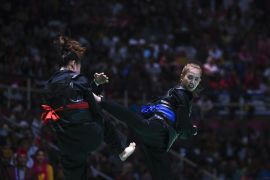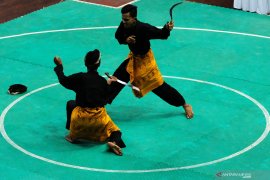The pupils have come to Lau`s Hong Kong studio -- some from as far away as Italy -- to hone their moves in the kung fu style called wing chun, which is on the rise again decades after the death of its most famous follower, Bruce Lee.
Many credit wing chun`s renewed popularity to a series of films about Yip Man, one of the art`s greatest "sifus", or teachers, and most famously the man who turned Lee from street fighter to martial arts legend.
"I started to learn wing chun because of the movie `Ip Man`. He was a great person," said Sam Ng (12). "When Yip Man saw someone beating someone else, he would stand up and help to rescue them."
Ng shows off a series of sharp chopping gestures followed by a formal bow.
But though students may be brought to wing chun by the 2008 blockbuster starring Donnie Yen -- or its sequel and prequel -- it is the health and self-defence benefits that keep them sparring, said Yip`s son, Yip Ching (77).
"Yip Man let the world know about wing chun but it`s even more popular now," he said.
Lau (64) was once Yip`s assistant and is now a sifu in his own right with over 1,000 pupils. He says that wing chun appeals to a broad range of students because of its emphasis on cunning and focus rather than brute force.
Like other adherents, he constantly brings up wing chun`s founding legend -- that of a young woman in southern China during the Qing dynasty, Yim Wing Chun, who used techniques taught to her by a nun to overcome a local warlord trying to trap her into marriage.
Yip Man brought her art to Hong Kong and, through Bruce Lee and the heyday of Hong Kong film, to the attention of the world.
"A lady in a dangerous situation can do something very serious, very fierce -- attack the eye, the chin, the neck -- wing chun is real fighting, real defence that relies on your technique," Lau said.
Fortunately, Lau`s studios in Hong Kong`s teeming Tsim Sha Tsui are free of pupils gouging one another`s eyes out.
Instead they stand in pairs grappling with their arms in an exercise called chi sao, or "sticky hands" -- a key element of wing chun in which students learn to respond instantly to an opponent`s movements.
Other exercises involve kicks and punches, while students may also train with wooden dummies and, in advanced stages, poles or swords.
Students learn to outwit opponents with speed and deliver multiple punches in quick succession while staying balanced around a centre line.
The most important exercises are not the most spectacular, but Lau`s students say they train the body to react faster than the brain.
They also lead to a different state of mind and body in which relaxation enables total focus, says Lau`s disciple, Italian Furio Piccinini.
"Even when punching incredibly fast you have to also be relaxed ... Normally you think that to punch you use force, but that`s not true, you use the body weight to punch and to develop power," he said.
"If you are relaxed, you can develop great power. I think that`s incredible -- it`s like geometry, physics. With a simple movement you can push very, very hard."
Piccinini (34) and his colleague Silvio Gazzaniga regularly bring students from near Milan to Hong Kong for lessons.
Erica Rossetti (23) started learning three years ago because her boyfriend went to the classes, but before long found some of the spark of the original wing chun.
"I like it because now I am not shy," she said. "Before, I was shy, but now I have found a different part of myself. I have more positive energy."
Lau also credits the growth in student numbers to the Internet, which allows would-be martial artists to instantly find Yip`s followers and their kung fu schools rather than what he sees as cheap imitations.
"Wing chun is the best kung fu in the world, and we have to tell the world, this is the correct wing chun," he said. "People see my website, they say this is very good, this is Bruce Lee again."
But exact numbers of wing chun students around the world are hard to come by, and this, says Lau, is a symptom of wing chun`s problems.
With roots in down-and-dirty street fighting, the sport has no standardised system of exams and competitions, and lacks the international profile of other martial arts like judo and taekwondo.
Lau sees it as his mission to "unify wing chun" to preserve Yip Man`s techniques for the future.
"I have been asking the Chinese government to promote wing chun, to develop it and tell the world to follow," he said. "But they only know about gold medals and the Olympic Games.
"We can`t wait for them. We have a duty to do this with or without the government."
With several teachers claiming to be the heirs of Yip Man, Lau`s quest to become the head of a united wing chun movement may prove difficult.
But the crowd that gathers at Yip`s grave for an autumn commemoration shows the old man is far from forgotten.
Some European visitors have no language in common with Yip`s local fans, but all rowdily honour him with incense, rice wine and a whole barbecued pig.
One Hong Kong disciple, Tony Ng, has only been learning for a year but sees wing chun featuring heavily in his future.
"I`m learning to use my whole body for fighting," he said. "It`s very easy to say but very difficult to do."
AFP
Editor: Jafar M Sidik
Copyright © ANTARA 2011









